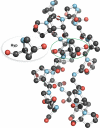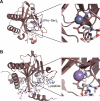Prolyl 4-hydroxylase
- PMID: 20199358
- PMCID: PMC2841224
- DOI: 10.3109/10409231003627991
Prolyl 4-hydroxylase
Abstract
Posttranslational modifications can cause profound changes in protein function. Typically, these modifications are reversible, and thus provide a biochemical on-off switch. In contrast, proline residues are the substrates for an irreversible reaction that is the most common posttranslational modification in humans. This reaction, which is catalyzed by prolyl 4-hydroxylase (P4H), yields (2S,4R)-4-hydroxyproline (Hyp). The protein substrates for P4Hs are diverse. Likewise, the biological consequences of prolyl hydroxylation vary widely, and include altering protein conformation and protein-protein interactions, and enabling further modification. The best known role for Hyp is in stabilizing the collagen triple helix. Hyp is also found in proteins with collagen-like domains, as well as elastin, conotoxins, and argonaute 2. A prolyl hydroxylase domain protein acts on the hypoxia inducible factor alpha, which plays a key role in sensing molecular oxygen, and could act on inhibitory kappaB kinase and RNA polymerase II. P4Hs are not unique to animals, being found in plants and microbes as well. Here, we review the enzymic catalysts of prolyl hydroxylation, along with the chemical and biochemical consequences of this subtle but abundant posttranslational modification.
Figures








Similar articles
-
Bacillus anthracis Prolyl 4-Hydroxylase Modifies Collagen-like Substrates in Asymmetric Patterns.J Biol Chem. 2016 Jun 17;291(25):13360-74. doi: 10.1074/jbc.M116.725432. Epub 2016 Apr 21. J Biol Chem. 2016. PMID: 27129244 Free PMC article.
-
Characterization of a second Arabidopsis thaliana prolyl 4-hydroxylase with distinct substrate specificity.J Biol Chem. 2005 Jan 14;280(2):1142-8. doi: 10.1074/jbc.M411109200. Epub 2004 Nov 4. J Biol Chem. 2005. PMID: 15528200
-
Conformational preferences of substrates for human prolyl 4-hydroxylase.Biochemistry. 2008 Sep 9;47(36):9447-55. doi: 10.1021/bi8009373. Epub 2008 Aug 15. Biochemistry. 2008. PMID: 18702512 Free PMC article.
-
Role of prolyl hydroxylation in the molecular interactions of collagens.Essays Biochem. 2019 Sep 13;63(3):325-335. doi: 10.1042/EBC20180053. Print 2019 Sep 13. Essays Biochem. 2019. PMID: 31350381 Free PMC article. Review.
-
Prolyl 4-hydroxylases, key enzymes in the synthesis of collagens and regulation of the response to hypoxia, and their roles as treatment targets.Ann Med. 2008;40(6):402-17. doi: 10.1080/07853890801986594. Ann Med. 2008. PMID: 19160570 Review.
Cited by
-
Comprehensive analysis reveals that P4HA3 is a prognostic and diagnostic gastric cancer biomarker that can predict immunotherapy efficacy.Sci Rep. 2024 Oct 3;14(1):22959. doi: 10.1038/s41598-024-73784-z. Sci Rep. 2024. PMID: 39362976 Free PMC article.
-
Selective inhibition of prolyl 4-hydroxylases by bipyridinedicarboxylates.Bioorg Med Chem. 2015 Jul 1;23(13):3081-90. doi: 10.1016/j.bmc.2015.05.003. Epub 2015 May 11. Bioorg Med Chem. 2015. PMID: 26022078 Free PMC article.
-
Correlation between protein secondary structure and mechanical performance for the ultra-tough dragline silk of Darwin's bark spider.J R Soc Interface. 2021 Jun;18(179):20210320. doi: 10.1098/rsif.2021.0320. Epub 2021 Jun 16. J R Soc Interface. 2021. PMID: 34129788 Free PMC article.
-
Hypoxia-inducible factor prolyl hydroxylases as targets for neuroprotection by "antioxidant" metal chelators: From ferroptosis to stroke.Free Radic Biol Med. 2013 Sep;62:26-36. doi: 10.1016/j.freeradbiomed.2013.01.026. Epub 2013 Jan 31. Free Radic Biol Med. 2013. PMID: 23376032 Free PMC article. Review.
-
Prolyl hydroxylation regulates protein degradation, synthesis, and splicing in human induced pluripotent stem cell-derived cardiomyocytes.Cardiovasc Res. 2016 Jun 1;110(3):346-58. doi: 10.1093/cvr/cvw081. Epub 2016 Apr 19. Cardiovasc Res. 2016. PMID: 27095734 Free PMC article.
References
-
- Adefarati AA, Giacobbe RA, Hensens OD, Tkacz JS. Biosynthesis of l-671,329, and echinocandin-type antibiotic produced by Zalerion arboricola: Origins of some of the unusual amino acids and the dimethylmyristic acid side chain. J Am Chem Soc. 1991;113:3542–3545.
-
- Aldunate R, Casar JC, Brandan E, Inestrosa NC. Structural and functional organization of synaptic acetylcholinesterase. Brain Res Rev. 2004;47:96–104. - PubMed
-
- Annunen P, Helaakoski T, Myllyharju J, Veijola J, Pihlajaniemi T, Kivirikko KI. Cloning of the human prolyl 4-hydroxylase α subunit isoform α(II) and characterization of the type II enzyme tetramer. J Biol Chem. 1997;272:17342–17348. - PubMed
-
- Atreya PL, Ananthanarayanan VS. Interaction of prolyl 4-hydroxylase with synthetic peptide substrates: A conformational model for collagen proline hydroxylation. J Biol Chem. 1991;266:2852–2858. - PubMed
-
- Bächinger HP. The influence of peptidyl-prolyl cis–trans isomerase on the in vitro folding of type III collagen. J Biol Chem. 1987;262:17144–17148. - PubMed
Publication types
MeSH terms
Substances
Grants and funding
LinkOut - more resources
Full Text Sources
Other Literature Sources
